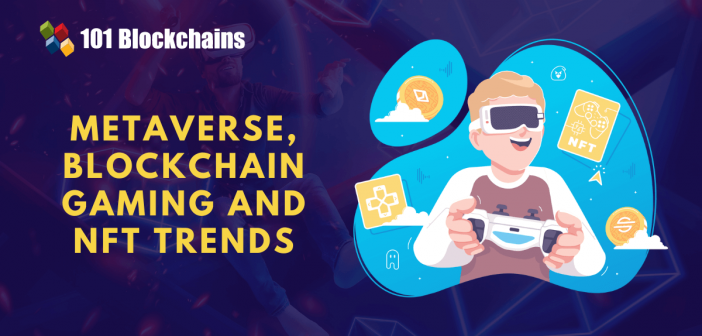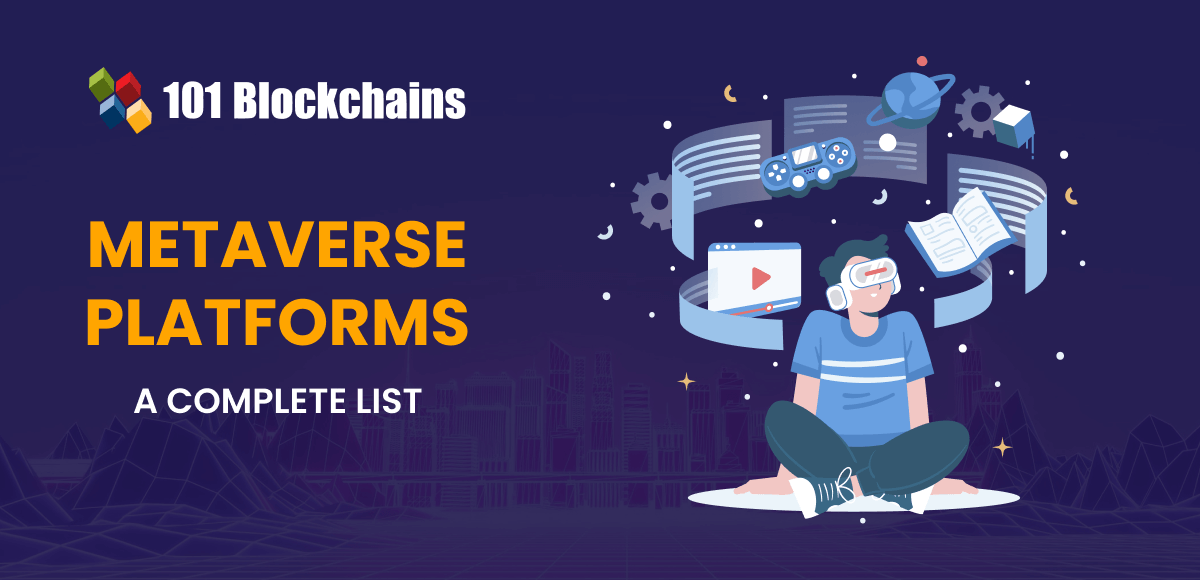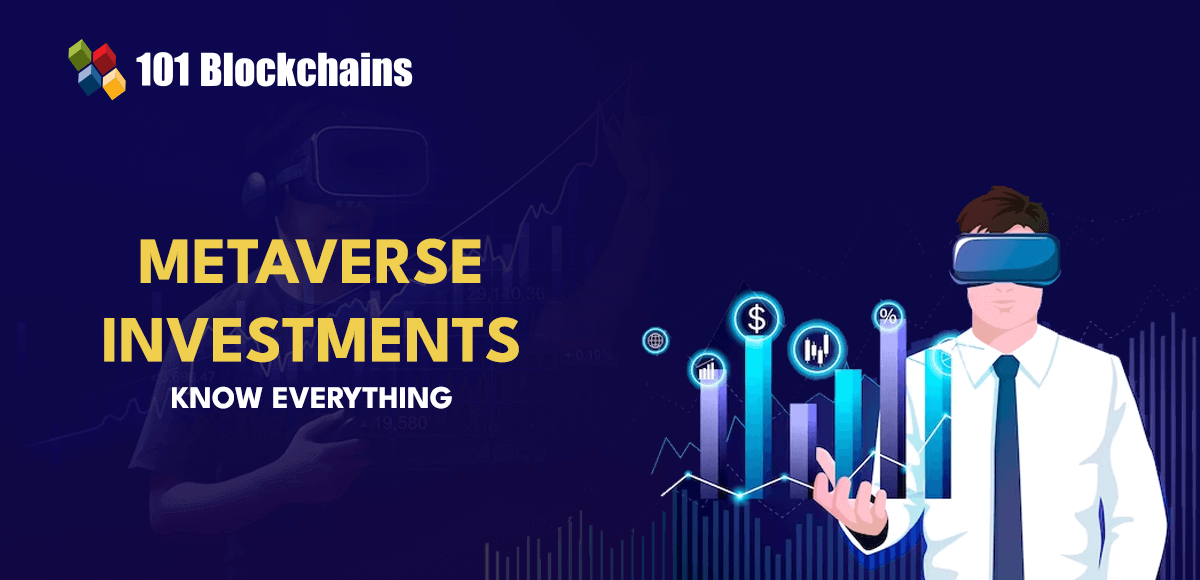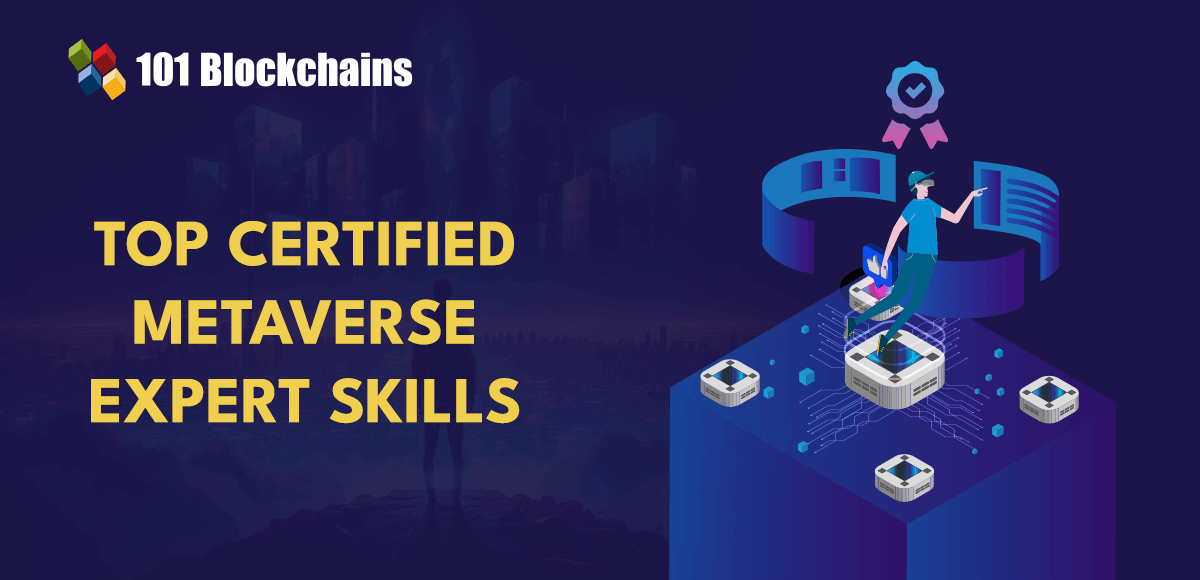Learn how blockchain truly works, master key definitions, and uncover what makes smart contracts so "smart." Dive into the fundamentals, gain valuable insights, and start your blockchain journey today!

- Metaverse
James Howell
- on January 08, 2025
Metaverse, NFTs, and Blockchain Gaming in 2025
The significant value advantages of innovation in technology are evident in the benefits of blockchain. It has encouraged the development of decentralized networks and applications alongside ensuring accessibility of digital services. Most important of all, the growth of blockchain has also resonated with the rise of metaverse, NFTs, and blockchain gaming.
The interest in metaverse blockchain gaming and NFT trends is gradually rising, especially considering how these industries are evolving. For example, NFTs have just been limited to the domain of artwork and digital collectibles, and the metaverse was just a term from a science fiction novel.
Now, NFTs can serve many use cases, including digital identity management and metaverse projects are real. At the same time, blockchain has also induced promising changes in the gaming industry, particularly with decentralization. The following discussion helps you discover the top trends which would define the future of blockchain gaming, metaverse, and NFTs.
Aspiring to Become a Certified Metaverse Expert? Enroll in Certified Metaverse Professional (CMP) Certification Course Now!
Understanding Metaverse, NFTs, and Blockchain Gaming
A basic understanding of metaverse, NFTs, and blockchain gaming is essential to identify how they relate to each other. As a matter of fact, you can find many overlapping similarities in metaverse trends and the ones for NFTs and blockchain gaming. All of them have one thing in common, i.e., blockchain technology.
Metaverse is an open and shared three-dimensional virtual environment that can facilitate interactions with different digital services and other users through digital avatars. On the other hand, you can also identify many other interpretations of the metaverse. However, the metaverse is still in the experimental stages, and the future of metaverse depends on various factors, including the development of hardware and standardization of user experiences.
The next important term in the scope of this discussion, non-fungible tokens, or NFTs, are innovative technological interventions. Based on a blockchain network, NFTs provide the opportunity for tokenizing almost anything, including virtual or physical assets. The NFT trends are quite significant for defining how they can revolutionize asset ownership.
Finally, the arrival of blockchain in the gaming industry has also pointed out many promising value advantages, especially with control of asset ownership. Gamers would have control over the gaming experiences they create in a blockchain-based game. Interestingly, NFTs have been one of the integral components in blockchain-based gaming, particularly for ownership of in-game collectibles and other assets. The play-to-earn or P2E gaming revolution has been inducing large-scale transformations which can set the foundation for blockchain gaming future with a good start.
The overview of basics pertaining to the metaverse, blockchain gaming, and NFTs show that they have some common elements. Metaverse would rely on blockchain technology for decentralization, while the foundation of NFTs is based on blockchain. Similarly, blockchain-based games use NFTs and are gradually developing as metaverse platforms. Therefore, it is important to learn how these three technologies will move ahead in the future. A detailed overview of prominent trends for each one of them can serve as a conclusive impression of their future.
Aspiring to Become a Certified NFT Expert? Enroll in Certified NFT Professional (CNFTP) Course Now!
Trends for Metaverse
The discussion on metaverse trends must start with an impression of their potential. Virtual concerts are a great hit, especially with almost 27 million people participating in the virtual concert of Travis Scott on Fortnite in 2020. The numbers pertaining to the metaverse also predict that it would evolve with a market opportunity of almost $800 billion by 2025.
With almost 32.8 million shipments of AR and VR devices expected by 2025, the adoption of metaverse would become easier. In addition, big tech companies are investing huge sums of money in metaverse development projects. One of the promising examples for the future of metaverse would refer to the $10 billion investment in Meta. All of these predictions and trends imply the possibility of a favorable foundation for the growth of the metaverse. Let us take a look at some of the notable highlights in the future prospects for the metaverse.
-
Metaverse Becomes Mainstream
One of the most significant highlights regarding the metaverse is that people are beginning to talk about the metaverse. It all started happening when Facebook announced a rebranding to Meta, with a vision for developing the metaverse. As a result, discussions around the metaverse started gaining mainstream attention. Subsequently, the boost in popularity of VR gaming has also offered proof of the prospects for increased public awareness.
-
More Money on Metaverse
The investment of $10 billion by Meta announced in 2021 was only the beginning. Meta has directed more humongous investments subsequently for metaverse development. On the other hand, metaverse trends also focus on the expenses on metaverse-related projects by Microsoft, which amount to almost $70 billion.
For example, Microsoft acquired Activision Blizzard. In addition, it also acquired Weta Digital for almost $1.6 billion. The growing interest of big players and many other corporate entities in the metaverse serve prolific indications for future developments in the metaverse.
Want to get an in-depth understanding of metaverse concepts?Enroll in Metaverse Fundamentals Course Now!
-
Metaverse Virtual Worlds
Metaverse virtual worlds also account for one of the formidable mentions among top metaverse blockchain gaming and NFT trends for the future. Virtual worlds are the most prominently visible highlights of the metaverse. The three-dimensional virtual worlds can provide immersive experiences with different activities such as creating art, socializing, or playing games.
For example, Horizon Worlds by Meta serves as a platform for exploring social interactions in a three-dimensional world. On the other hand, Decentraland has also emerged as one of the popular virtual worlds in the metaverse. Virtual parcels of land have been selling for millions on Decentraland, thereby implying the favorable potential for metaverse virtual worlds in the future.
-
Metaverse Entertainment
The interactive nature of the metaverse makes it an easy candidate for entertainment activities. It can help in bringing people together to celebrate events, whether they are cultural festivals, weddings, or concerts. Many popular stars have conducted virtual concerts with some notable names, including Twenty-One Pilots, Justin Bieber, and Ariana Grande.
-
Corporate Solutions in Metaverse
The future of metaverse would also focus on productive implications other than the scope of entertainment and relaxation. Metaverse would open up many opportunities for collaboration in virtual workspaces. Virtual meetings are the best example of the use cases of a metaverse in the corporate world. Augmented reality can also play a vital role in improving physical locations through metaverse-related augmentation.
Want to learn Metaverse concepts quickly? Check out Now Metaverse Flashcards and Metaverse FAQs
Trends in NFTs
The transition towards a digital landscape with virtual real estate and marketplaces through the metaverse provides some valuable advantages. At the same time, the non-fungible token or NFT market has set some new precedents for the future of digital assets, virtual markets, and the interactions between users. The global trading volume of NFTs in 2021 amounted to almost $23 billion. Some of the other NFT trends point to the rising number of artists and different applications of NFTs. Here are some of the significant highlights expected in the domain of non-fungible tokens.
-
The NFT and Metaverse Equation
Non-fungible tokens came to the mainstream with the first NFT game, CryptoKitties. Many other businesses and developers have capitalized on the idea of leveraging tokens for financial incentives. The evolution of non-fungible tokens has also developed them as important assets for the metaverse. NFTs can work as tools for facilitating exchange of assets with verifiable proof of ownership in the metaverse.
-
NFTs and Digital Identity
The most promising application of NFTs, which would determine the future of NFT, refers to the PFP revolution. Do you know about CryptoPunks? The algorithmically created pixelated artworks were distributed for free to everyone with an ETH wallet. Now, the cheapest image in the CryptoPunks collection would cost around $40,000. At the same time, the most expensive one amounted to almost $23.7 million.
NFTs can provide a viable tool for representing digital identity as the picture would serve as a form of digital identification. With the help of an NFT, the owner could access close communities, among other benefits. The initiatives of Twitter for an NFT verification mechanism also indicate the prospects for the adoption of NFTs in digital identity use cases. As a matter of fact, PFP or profile picture NFTs have considerable potential for becoming major components in the metaverse and web3.
-
AI NFTs
Not only humans but AI would also take a chance at the world of NFTs. The most striking entry among NFT trends would refer to the creation of NFT paintings through AI capabilities. For example, an algorithm named GAN created $400,000 worth of artwork. It is also important to note the possibilities for a rise in innovative use cases of NFTs such as iNFTs. The iNFTs would basically have the accents of an AI personality or as a virtual entity with which you can interact. You can notice the possibilities for integration of the capabilities of personal assistants in NFTs.
-
Evolving Use Cases of NFTs
The prospects for the future of NFT always depend on how effectively non-fungible tokens can adapt to new use cases. NFTs can transform the artwork space with the opportunity for fractionalization. Therefore, NFTs could help in encouraging community-shared ownership of expensive artwork pieces. The applications of NFTs in the world of music, especially with NFT music albums, showcase the possibilities for the growth of NFTs in the future.
They can offer a better channel for artists to connect with their audience and reap the justified financial remunerations for their work. Most important of all, brand NFTs are also one of the significant NFT trends which can influence the future course of the industry. Big brands such as Burger King, McDonald’s, and Nike are capitalizing on NFTs, and it is definitely one of the top trends in the emerging use cases of non-fungible tokens.
Want to get an in-depth understanding of non-fungible tokens (NFTs)? Enroll Now in NFT Fundamentals Course.
Trends for Blockchain Gaming
The formidable growth of play-to-earn gaming is one of the notable metaverse blockchain gaming and NFT trends to look out for. It has basically opened up the possibilities for the expansion of blockchain-based gaming. The blockchain gaming industry registered a humongous growth rate of almost 2000% in the last year.
In addition, investments in blockchain-based gaming projects amounted to almost $4 billion in 2021. Apart from the popular play-to-earn alternatives, blockchain gaming has also included free-to-play games, which can encourage the adoption of blockchain-based games. The primary emphasis of blockchain gaming trends would revolve around the value advantages of blockchain in gaming.
Decentralized systems complemented with cryptographic security can deliver secure gaming experiences. Similarly, support of other technologies such as NFTs can help in offering the assurance of true ownership over in-game assets and experiences. Here are some of the notable trends to look out for in blockchain gaming.
-
Play to Earn Gaming on Rising
Play to Earn or P2E games have been the biggest highlight in blockchain gaming future predictions. As a matter of fact, P2E games have served the foundation for strengthening the blockchain gaming industry. Many notable examples, such as OP Games, show the use of web3 gaming arcades for purchasing, ownership, and trading of in-game assets.
OP Game converts the assets into collectible NFTs, which the owners can use in environments outside the OP Games ecosystem. In addition, the platform has also introduced fractionalized NFTs, which can help players to exercise co-ownership over assets they like. On top of it, the play-to-earn gaming platform also presents vital insights into the governance of P2E gaming platforms by leveraging its native DAO.
The example of Axie Infinity also shows how blockchain gaming trends could influence the future of web3. It encouraged the use of NFTs in blockchain-based games while also offering the excitement of an arcade game. Players could breed creatures and fight in battles for rewards in the form of tokens. The characters are encoded as NFTs, which are under the ownership of players with specific distinguishable traits.
Another example of a play-to-earn gaming platform would refer to Vorto Network, which is an online marketplace. Players could utilize a crypto wallet for purchasing in-game digital assets and items. The Hash Rush game on Vorto Network provides an immersive experience to players with a real-time strategy mission. It is one of the formidable examples of driving a creator economy through P2E games.
-
Confluence with Social Media
The next important highlight for blockchain gaming future would refer to the convergence with social media. Blockchain-based games can also serve as an alternative or hybrid social media networks. For example, the Near Lands game features an open-world pixelated land-based design. Interestingly, the community experience of the game is a more prominent highlight of the game rather than its gameplay.
Players could develop items and characters over the course of their adventures in the open world of the game. The example of Reality Chain is also another reason to consider favorable prospects for the future of blockchain gaming. Reality Chain tries an attempt at creating a multi-chain, social gaming metaverse, launched recently on Octopus Network.
Build your identity as a certified blockchain expert with 101 Blockchains’ Blockchain Certifications designed to provide enhanced career prospects.
Final Words
The different metaverse blockchain gaming and NFT trends show that they have the adequate potential for revolutionizing the future. However, the major aspect which you must note in the trends for metaverse, NFTs, and blockchain gaming is the role of blockchain. Blockchain offers the foundation of decentralized networks to build these solutions while the individual functionalities make them support each other.
For example, the immersive design of the metaverse is an ideal requirement for blockchain gaming. On the other hand, the uniqueness of NFTs helps in using them as proof of digital identity in metaverse platforms. All these interconnected technological marvels would definitely impose a conclusive impact on the growth of the web3. Explore the world of web3 and how to use these technologies to your advantage.
*Disclaimer: The article should not be taken as, and is not intended to provide any investment advice. Claims made in this article do not constitute investment advice and should not be taken as such. 101 Blockchains shall not be responsible for any loss sustained by any person who relies on this article. Do your own research!





